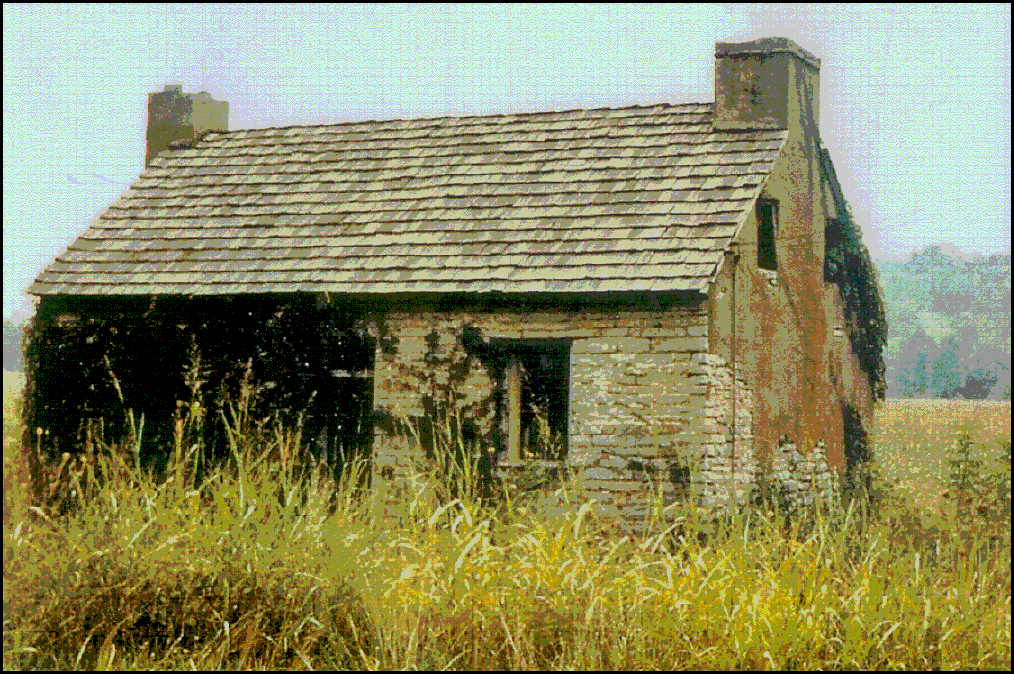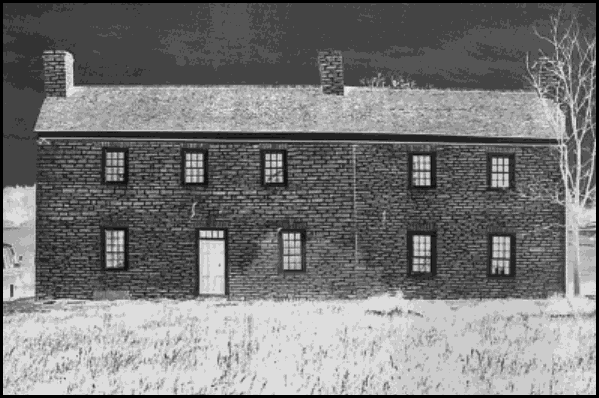
Early Stone Houses
of Kentucky
Carolyn Murray-Wooley
(University Press of Kentucky)

In the late 18th Century, the classe supérieure of Virginia, being, by nature, like the upper class of all of the Americas, vagabonds and thieves, claimed much of the Upper Middle West as their own territory. This included present day Michigan, Ohio, Wisconsin, Kentucky, and parts of Canada. The clear winners were those who studied the land."Surveyors," Ms. Murray-Wooley tells us, "played a critical and lucrative role in the distribution of Kentucky estates, reserving the best land for themselves and their friends." The aristocrats, the surveyors and the militia divvied up the estates, casting out the original inhabitants (Indians, squatters) carving it all into large plots which they later sold to the hoi polloi, those who were looking for nothing more than a place to hang their buck-skins and muzzle-loaders.
Being scoundrels and thieves, that is to say, for the most part, Presbyterians --- "the landholding elite of large planters provided a traditional leadership structure for the conduct of political and civic affairs." The most elegant meets and bounds they reserved for themselves, bringing along their servants, wives, and slaves (who, often as not, this being a Jeffersonian democracy, were somewhat interchangeable, pro forma if not pro bono.)
In Central Kentucky, there to the south of Frankfort, they hired on stone masons to build strong houses for them to live in. Because of the ill-tempered natives --- ill-tempered because they had been dispossessed of all their landholdings --- they were forced to build solely within the 18th Century equivalent of "gated communities:" Fort Nelson, Fort Hill, Fort Harrod --- including but not limited to Fort Knox which was later to be reserved for weightier things, a depository for 368,000 troy ounces of bullion soup to feed the restless if not hungry parvenus. (And, oddly enough, atop all them soon-to-be-melted-down coins, there was a storage vault for the Hungarian Crown Jewels).
Once the natives were suitably pacified by the militia, the gentry moved onto their estates and commenced to distill a heady mix of blue grass (for the horses) and fine straight bourbon (for the masters) and to build large square houses of stone (for the women-folk): plantations that included tobacco barns, chicken houses, icehouses, hemp houses --- no, no, not that kind of hemp --- and, at some distance, usually downstream, rude structures for the slaves.Ms. Murray-Wooley follows the fortunes of forty-five early Kentucky families, mostly Ulster, along with the history of their stately homes. Some of these houses survive to this day. A typical entry in Early Stone Houses will include drawings and photographs, details of the structure and interior ... along with facts of the original owner and succeeding generations.
For instance, Thomas Kennedy of Bourbon County was a stonemason and later a physician, "a man of great fortitude in whatever he conceived to be the path of duty." He built a gorgeous pile [see Fig 3, in reverse, below] which "faced west and was situated on a rise above Kennedy Creek at the back."
His story is a sad one, though: his original tract of 1400 acres was reduced to 150 by confused claims, including suits by his in-laws, but he was still able "to retain his slaves and stone house in Bourbon County." The house itself with its "fine ashlar stone" burned in 1982 while being restored, and its ruins remain to this day to draw a tear from the eyes of those of us who love great old stone homes, Kentucky or no.
The vocabulary of these structures can be devilish. One is called upon to consider "dogleg stairs," "summer beams," "chimney stacks," "reveals" (sides of doors and windows), "collar ties" (horizontal beams), and "voussoirs" (wedge-shaped stones in masonry arches). Further, the construction was no piece of cake. Large and weighty stones --- mostly limestone --- had to be cut and hauled from the fields to the appropriate location, then shaped and placed in "Flemish bond," "coursed rubble," "broken ashlar," or "ranged work." No matter how built, few of the very early homes have survived, "lost to neglect, demolition, and alteration."
Of the 455 known stone dwelling houses of the Kentucky settlement period, only 156 have been maintained or restored.
Indeed, of the hundred or so black-and-white photographs and the thirty-two color ones, the most troubling are photographs of those that fell into disrepair, now available to what the author refers to as builders of "vinyl-clad housing" to disassemble in order to spawn their disgusting modern-day plastic structures.
Ms. Murray-Wooley, because of or despite her improbable name, is founder of the "Dry Stone Conservancy" (!) and formerly director of the "Bluegrass Trust for Historic Preservation." It all reeks of horses and high-grade bourbon ... but the beauty and the effort of this volume are a tribute to the past and to her noble efforts. Long may they wave.

--- Lolita Lark